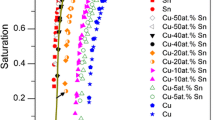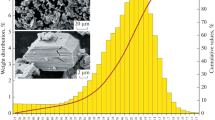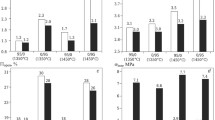Abstract
The permeabilities of nanocrystalline 3 mol% yttria-stabilized zirconia (3Y-TZP), silica, and boehmite powder compacts are measured during their formation by constant rate pressure filtration. The Carman–Kozeny equation with no account for the effect of adsorbed water often overestimates by a factor of 2 or more the measured permeabilities, with increasing deviation with decreasing permeability. A permeability equation from the literature and one derived here, both taking into account the effect of adsorbed water, show significant improvement over the classic Carman–Kozeny equation for predicting measured permeabilities. The equation derived here allows straightforward predictions to be made of how permeability will change as the critical point of drying (when shrinkage stops) is approached.
Similar content being viewed by others
References
L. Svarovsky, in Solid-Liquid Separation, 3rd edn., ed. by L.␣Svarovsky (Butterworth & Co. Ltd., London, 1990), p. 321
G.W. Scherer, J. Am. Ceram. Soc. 73, 3 (1990)
S.J. Glass, D.J. Green, J. Am. Ceram. Soc. 82, 2745 (1999)
G.W. Scherer, J. Am. Ceram. Soc. 83, 2231 (2000)
G.W. Scherer, J. Non-Crystal. Solids 130, 157 (1991)
A. Scheidegger, The Physics of Flow Through Porous Media (The Macmillan Co., New York, 1960), p. 129
P.C. Carman, J. Agric. Sci. 29, 262 (1939)
W. Vichit-Vadakan, G.W. Scherer, J. Am. Ceram. Soc. 83, 2240 (2000). Erratum J. Am. Ceram. Soc. 87, 1614 (2004)
G.W. Scherer, J. Sol-Gel Sci. Technol. 1, 285 (1994)
R.P. Mayer, R.A. Stowe, J. Colloid Sci. 20, 893 (1965)
J. Israelachvili, Intermolecular & Surface Forces, 2nd edn. (Academic Press, London, 1992), p. 110
J. Hagymassy Jr., S. Brunauer, R.S.H. Mikhail, J. Colloid Interf. Sci. 29, 485 (1969)
E. Nilsen, M.-A. Einarsrud, G.W. Scherer, J. Non-Crystal. Solids 221, 135 (1997)
S. Wallace, L.L. Hench, J. Sol-Gel Sci. Technol. 1, 153 (1994)
M. Ciftcioglu, M.J. Mayo, in Superplasticity in Metals, Ceramics, and Intermetallics, ed. by M.J. Mayo, M. Kobayashi, J. Wadsworth (MRS, Pittsburgh, 1990), p. 77
S.M. Sweeney, PhD Thesis in Materials Science and Engineering, The Pennsylvania State University, University Park, PA (2005)
D.R. Lide (ed.), CRC Handbook of Chemistry and Physics, 72nd edn. (CRC Press, Inc., Boca Raton, FL, 1991), p. 6/9
R.P. Ingel, D. Lewis III, J. Am. Ceram. Soc. 69, 325 (1986)
D.R. Lide (ed.), CRC Handbook of Chemistry and Physics, 72nd edn. (CRC Press, Inc., Boca Raton, FL, 1991), p. 4/36
D.R. Lide (ed.), CRC Handbook of Chemistry and Physics, 72nd edn. (CRC Press, Inc., Boca Raton, FL, 1991), p. 4/95
E.P. Barrett, L.G. Joyner, P.P. Halenda, J. Am. Chem. Soc. 73, 373 (1951)
G.W. Scherer, J. Non-Crystal. Solids 215, 155 (1997)
H.P. Meissner, A.S. Michaels, R. Kaiser, I. & E.C. Process Des. Dev. 3, 202 (1964)
Acknowledgements
The support of the Office of Naval Research, Contract No. N00014-98-1-0637 was greatly appreciated. Thanks to G.W. Scherer for helpful discussions of his permeability equations.
Author information
Authors and Affiliations
Corresponding author
Appendix
Appendix
1.1 Derivation of an adsorbed water-modified Carman–Kozeny equation
To account for the effect of an immobile adsorbed water layer on pore surfaces, the effect of this layer upon each variable of the Carman–Kozeny equation (Eq. 1) will be considered. Assuming monosized spherical particles, and recognizing that the surface area per solid volume, S A, is equal to ρth S, first the volume and surface areas of a particle plus its adsorbed water layer must be determined.
For the case of particles with a layer of adsorbed water of thickness δa at contacts between particles, and an adsorbed water layer thickness of δ around the rest of the particle surfaces, the volume of a particle plus its associated adsorbed water layer can be approximated using the geometry of Fig. 6. The radius of the sphere, R sphere, is here equal to R p + δ, since “sphere” refers to the particle plus its adsorbed water layer. The volume of the particle plus its associated adsorbed water layer is simply the volume of a contact-free particle plus its adsorbed water layer, minus the volume of adsorbed water excluded per contact times the number of contacts per particle. The volume of adsorbed water “excluded” in the contact region between particles is taken as the volume of a planar slice off of a sphere of radius R p + δ:
where x is the depth of the planar “cut” into the sphere (see Fig. 6). Using this expression with x given by δ-δa/2 (taking the planar cut as occurring halfway between particles, i.e., in the middle of the adsorbed water layer between them), we find (noting that the volume of a sphere is 4π R 3sphere /3):
where n c is coordination number, i.e., number of contacts per particle. Here a “contact” is defined as occurring when there is overlap between the adsorbed water layers of adjacent particles, not necessarily between the solid particles themselves.

As in the case of volume, the surface area of the particle plus its associated adsorbed water layer is just the surface area of a contact-free particle plus its adsorbed water layer, minus the surface area excluded per contact times the number of contacts per particle. The excluded surface area due to the planar cut through a sphere at a particle contact is (see Fig. 6)
Noting again that x = δ-δa/2, that R sphere = R p + δ, and that the surface area of a sphere is 4π R 2sphere , the surface area (area that touches “free” water in the pores) of this particle/adsorbed water ensemble is
Meissner et al. [23] gave the following approximate expression for coordination number, n c, versus particle packing density:
In Eq. (14), the dry particle packing density, ρd, is used because, as mentioned above, two particles are considered to be in contact if their adsorbed water layers overlap. With contacts defined in this way, and if it is assumed that no particle rearrangement occurs during drying, then particles whose adsorbed water layers are in contact in the wet state will be in direct contact in the dry state, and therefore the coordination number of particles plus their adsorbed water layers in the wet state will be the same as of the coordination number of particles in the dry state.
The surface area per volume of the particle plus its adsorbed water layer, S ′A , is obtained by dividing the surface area of a particle plus its adsorbed water layer (Eq. 13) by the volume of a particle with its adsorbed water layer (Eq. 11), and by using Eq. (14) to yield
The relative density of packings of particles plus their adsorbed water layers is found by multiplying the apparent density of the particle packing, ρ, by the ratio of the volume of the particle plus its adsorbed water (Eq. 11) to the volume of the particle by itself, to obtain:
Using Eqs. (15) and (16) for the expressions for ρth S and ρ, respectively, in Eq. (1) gives
This complicated expression reduces for the case where δa = 2δ, i.e., when particles are separated by twice the thickness of the adsorbed water layer on each particle, to a simpler form:
Rp can be approximated as the surface area-equivalent spherical particle radius, i.e., Rp = 3/Sρth. Note also that by assuming that δ does not change during drying, and setting δa = 0 and ρ = ρd in Eq. (17), the permeability of a compact at the critical point of drying (when shrinkage stops) can be predicted.
Rights and permissions
About this article
Cite this article
Sweeney, S.M., Mayo, M.J. Effect of adsorbed water upon permeabilities of pressure-filtered ceramic nanopowder compacts. J Porous Mater 14, 81–88 (2007). https://doi.org/10.1007/s10934-006-9011-4
Published:
Issue Date:
DOI: https://doi.org/10.1007/s10934-006-9011-4




